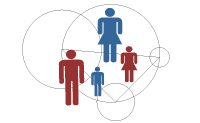Personal names
 What is a personal name?
What is a personal name?
Names have been used for as long as we have any records. It simply seems to have been natural for human beings to give each other names – and this was also a uniquely human achievement. We give names in order to distinguish ourselves from everyone else but also in order to signify that we belong together. This is clearly revealed in the custom of bestowing on a child both a forename and a surname or last name. The forename shows that we are talking of an individual, while the surname shows that this same individual is part of a family.
It is not only for practical reasons that naming takes place. If that had been the case, it would have been easier simply to employ unambiguous number codes. The use of personal names also has an emotional dimension. They are linked with feelings and associations and their sound and their meaning are of significance.
The first Danish personal names that we know about
The oldest personal names that are known from Denmark are about 2000 years old. Names must have existed in Denmark much earlier than that but we do not have any written sources that go further back than to the Iron Age in the first centuries A.D. The oldest personal names are found in brief runic inscriptions on weapons, ornaments and other small objects where the owner has inscribed his name – or where the craftsman who fashioned the object has written his own name.
The inscription on the golden horn from Gallehus in Southern Jutland is probably the most well known inscription. It reads, "I HlewagastiR Forest-dweller made the horn". HlewagastiR would have developed into Lægæst if the name were still in use today. The personal name in the inscription on the golden horn is one of the few pieces of evidence that we have about what the inhabitants of the country called themselves and each other before the Viking Age.
